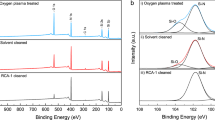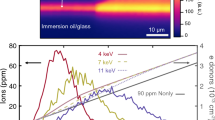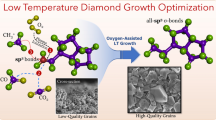Abstract
Despite the many superior attributes of diamond, electronic device performance to date has fallen well behind theoretical expectation. The potential realization of highly efficient electronic polycrystalline diamond devices has been more than limited by certain technological challenges such as maintaining efficient/shallow n-type doping without higher density of defects or incorporation of sp2 bonded carbon as a result of doping(during ion implantation process). Specific n-type diamond reports demonstrating phosphorus doping (with activation energy reported in the range of 485 meV to 600 meV in (100) oriented systems have been particularly problematic as a lower solubility is found as compared to (111) oriented synthesis efforts, in addition to the reported self-compensating nature. Amongst the previous reports of Phosphorus-doped diamond nearly all experimental reports to date show visual crystallographic dislocation/pitting on the (100) facet with even moderate doping where dislocations have been observed to be incorporated into the bulk volume during growth. These dislocations, which are known carrier scattering sites, subsequently lower mobility rendering poor conductance and high resistivity. Due to this well-known sensitivity of phosphorus incorporation to the crystal quality, typically lower in polycrystalline than homoepitaxial films, polycrystalline-based experimental reports have been largely absent. With respect to Phosphorus in-situ doping based efforts, rendered films demonstrate both the visually identifiable pitting and electronically identifiable poor conduction characteristic, and with respect to ion beam doping efforts, complete graphitic flaking at even moderate doses (i.e. greater than 3×1017cm−3). Motivated by these shortcomings and the success of recent experimentation, we present the methodology and data from our recent successful fabrication of polycrystalline diamond P+-i-N junction (diode) with high crystal quality, high power handling capability, high current density, low threshold voltage, and ohmic contact, under room temperature operation, previously undemonstrated across all diamond material types. The superior electrical performance of the device was obtained by novel ion beam methodology designed to resolve previously unaddressed issues relating to n-type doping of diamond materials. A high current density of approximately 104 A/cm2 is attained at 20V forward bias.
Similar content being viewed by others
References
H. Okushi, Phys. Stat. Sol.(a) 203, No. 13, 3226–3244 (2006)
S. Koizumi, Phys. Stat. Sol.(a) 172, No. 21, 171–178 (1999)
N. Casanova {etet al.} Phys. Stat. Sol.(a) 181, 5–10 (2000)
H. Kato {etet al.}, Mater. Res. Soc. Symp., Proc. Vol. 1039 (2008)
H. Kato {etet al.}, Dia. Rel. Mat. 16 (2007)
S. Koizumi {etet al.}, Appl. Phys. Lett. 71, 1065 (1997)
Y. Yan {etet al.} Phys. Rev. B. Vol. 66, No. 68 (2002)
A. Khan “Diamond Semiconductor System and Method”, Patent US13/273,467 (2011)
A.H. Khan, A.V. Sumant, (2012), “Characterization of Moderately Phosphorus Doped N-type Nanocrystalline Diamond and Related Devices” (Manuscript in Review)
Schwingenschlogl {etet al.}, J. Appl. Phys. 110, 056107 (2011)
R. Kalish, Korean J. Ceram. 2, 188 (1996)
R. Kalish, Carbon 37, 781, (1999)
J. Bernholc {etet al.}, Phys. Rev. Lett. Vol. 61 No.23 (1988)
J. F. Prins, Phys. Rev. B. Vol. 38, 5576, (1988)
S. Dannefaer, K. Iakoubovskii, J. Phys. Condens. Matter 20 (2008)
I. Kiflawi {etet al.} Phil. Mag. B 78 (1998)
D.J. Twitchen {etet al.}, J. Phys. C 13. 2045 (2001)
I. Kiflawi, J. Bruley, Diam. Rel. Mater. 9 (2000)
T. Makino {etet al.}, Dia. Rel. Mat. 18 (2009)
M. Brezeanu {etet al.}, IET Circ. Dev. Syst., Vol. 1, No.5 (2007)
Acknowledgments
use of the Center for Nanoscale Materials was supported by the U. S. Department of Energy, Office of Science, Office of Basic Energy Sciences, under Contract No. DE-AC02-06CH11357. Project funding and materials were provided by AKHAN Technologies, Inc. The authors would like to thank the staff of CNM Argonne for process configuration and setup assistance
Author information
Authors and Affiliations
Rights and permissions
About this article
Cite this article
Khan, A., Sumant, A. On Enabling Nanocrystalline Diamond for Device Use: Novel Ion Beam Methodology and the Realization of Shallow N-type Diamond. MRS Online Proceedings Library 1478, 1–7 (2012). https://doi.org/10.1557/opl.2013.192
Published:
Issue Date:
DOI: https://doi.org/10.1557/opl.2013.192




